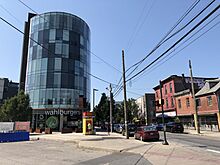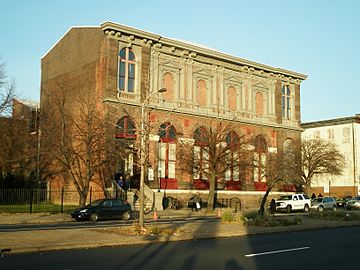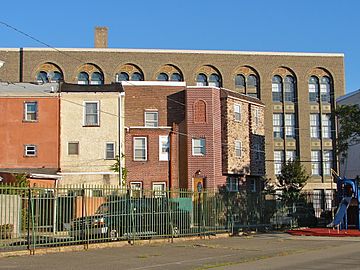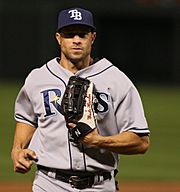Northern Liberties, Philadelphia facts for kids
Quick facts for kids
Northern Liberties District
|
|
|---|---|
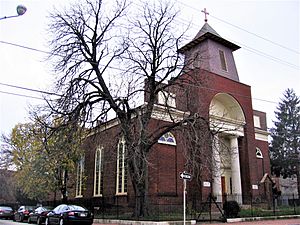
|
|
| Country | United States |
| State | Pennsylvania |
| County | Philadelphia |
| Time zone | UTC-5 (EST) |
| • Summer (DST) | UTC-4 (EDT) |
| Area codes | 215, 267 |
|
Northern Liberties Historic District
|
|
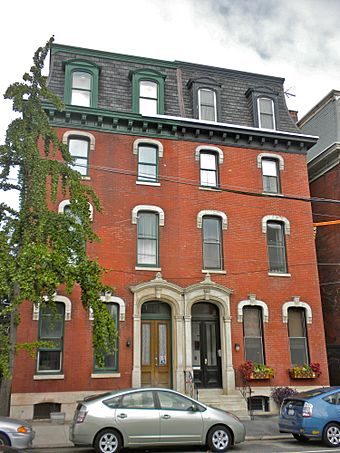
Houses on North 5th Street
|
|
| Location | Roughly bounded by Brown, Boone & Galloway, Green & Wallace, and Fifth & Sixth Sts. Philadelphia, Pennsylvania |
|---|---|
| Area | 20.5 acres (8.3 ha) |
| Built | 1791 |
| Architectural style | Greek Revival, Italianate, Federal |
| NRHP reference No. | 85003471 |
| Added to NRHP | October 31, 1985 |
Northern Liberties is a lively neighborhood in Philadelphia, Pennsylvania. It sits just north of the city center, right along the Delaware River. Before it became part of Philadelphia in 1854, Northern Liberties was one of the largest cities in the U.S. It was a big manufacturing area and welcomed many immigrants from Europe. Today, it's a popular spot for young people and has seen lots of new homes and businesses.
Contents
Where is Northern Liberties?
Northern Liberties is located north of Center City, specifically near Old City. Its borders are Girard Avenue to the north, Callowhill Street to the south, North 6th Street to the west, and the Delaware River to the east. The eastern border changes to North Front Street between Laurel Street and Girard Avenue.
In the past, the southern border was Vine Street. The northern border was the Cohocksink Creek. This creek now flows underground as a storm sewer.
A Look Back in Time
| Historical population | |||
|---|---|---|---|
| Census | Pop. | %± | |
| 1790 | 9,913 | — | |
| 1800 | 10,718 | 8.1% | |
| 1810 | 19,874 | 85.4% | |
| 1820 | 19,678 | −1.0% | |
| 1830 | 28,872 | 46.7% | |
| 1840 | 34,474 | 19.4% | |
| 1850 | 47,223 | 37.0% | |
Northern Liberties was once part of a larger area called Northern Liberties Township. In 1771, it gained some independence to manage its streets and buildings. By 1791, people living in a specific part of Northern Liberties could elect leaders. These leaders could collect taxes to pay for streetlights, security, and water pumps.
Growing Pains and Progress
During the late 1700s and early 1800s, Northern Liberties faced tough times. Many people got sick and died during the Yellow Fever outbreaks.
In 1803, a special law officially created the District of Northern Liberties. This district covered the area between Sixth Street and the Delaware River, and between Vine Street and Cohocksink Creek. However, in 1854, a law called the Act of Consolidation, 1854 made Northern Liberties a part of the city of Philadelphia.
A Hub for Newcomers
Early on, Northern Liberties was a great place for factories. Its location just outside Philadelphia helped it grow. Mills, breweries, leather tanneries, and factories making tools and iron goods were common. Because it was less crowded than Philadelphia, it was sometimes called "Philadelphia's first suburb."
In the 1800s, many skilled workers from Germany moved to Northern Liberties. Later, in the early 1900s, immigrants from Eastern Europe arrived. Many Slovaks and Romanians came seeking new opportunities. Slovaks built St. Agnes Slovak Roman Catholic Church. Romanians built Holy Trinity Romanian Orthodox Church, where their families still worship today.
From 1860 to 1987, a famous company called the Christian Schmidt Brewing Company was located here.
Protecting History
In 1985, the Northern Liberties Historic District was created. This district helps protect the beautiful old buildings in the area. These buildings show different styles like Italianate, Greek Revival, and Federal architecture. The historic district includes 209 important buildings. It was added to the National Register of Historic Places in 1985. Other historic places in Northern Liberties include the Daniel Boone School and St. John's Church.
Northern Liberties Today
Today, Northern Liberties is a popular neighborhood. Many young professionals, students, artists, and designers live here. The area has seen a lot of improvements and new construction. This has made property values go up. Because it's so close to Center City, it's a desirable place for both homes and businesses. Most homes are rowhouses, but new apartment and condo buildings have also been built.
Parks and Green Spaces
Northern Liberties has two public parks that are privately owned. Orianna Hill Park is a popular spot for dogs to play off-leash. The other park, Liberty Lands, is a 2-acre (8,100 m2) park with a playground.
Getting Around
You can get to Northern Liberties using SEPTA's Market–Frankford El train. There are stops at Spring Garden and Girard. The Spring Garden station is unique because it's in the middle of I-95. The train tracks then go above Front Street as they head north.
In 2005, the Girard Avenue trolley started running again. This trolley line runs along the northern edge of the neighborhood.
The doughboy statue is a special landmark in Northern Liberties. It was put up to honor local residents who served in World War I.
Local Businesses
Northern Liberties is home to many unique stores. You can also find lots of small bars and restaurants here. Yards Brewing Company and SEER Interactive headquarters are also located in the neighborhood.
Learning and Libraries
Schools in the Area
Students in Northern Liberties attend schools run by the School District of Philadelphia.
If you live south of Poplar Street, you would go to the General Philip Kearny School for grades Kindergarten through 8. After that, you would attend Benjamin Franklin High School.
If you live north of Poplar Street, you would go to James R. Ludlow School for grades Kindergarten through 8. Then, you would attend Kensington High School for grades 9 through 12.
Other schools in Northern Liberties include:
- Laboratory Charter School
- Walter D. Palmer Leadership Academy
- Bodine High School of International Affairs
Public Libraries
The Ramonita de Rodriguez Branch of the Free Library of Philadelphia serves residents. It is located at 600 West Girard Avenue. Before 1977, it was known as the Girard Avenue Branch.
Places of Worship
Northern Liberties has several churches and places of worship:
- Ukrainian Catholic Cathedral of the Immaculate Conception
- Immaculate Conception Catholic Church
- Seamens Church Institute
- St. Andrew's Russian Orthodox Cathedral
- St. Peter's Catholic Church/St. John Neumann Shrine
- St. Michael's Russian Orthodox
- Covenant House of God
- St. Agnes-St. John Slovak Catholic Church
- Second Christian Missionary
- Holy Trinity Romanian Orthodox Church
Famous Faces from Northern Liberties
Many interesting people have connections to Northern Liberties, including:
- Jake Elliott (born 1995), an American football kicker
- Gabe Kapler (born 1975), a former Major League Baseball player and manager
- James Landy (1813–1875), a politician
- John T. McIntyre (1871–1951), a novelist
- William Millward (1822–1871), a politician
- Albert F. Sabo (1920–2002), a lawyer and judge
- Charles Yerkes (1837–1905), a financier





